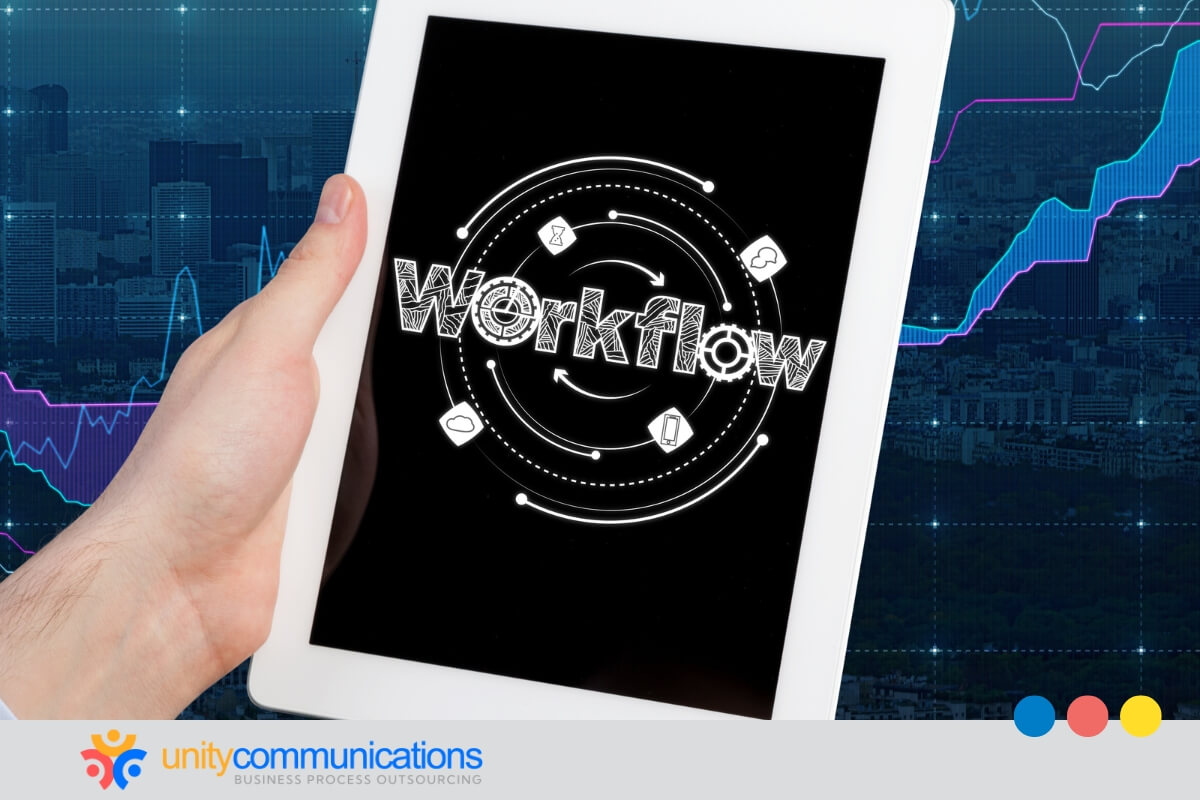Table of Contents
Human resource (HR) responsibilities can overwhelm organizations, especially when juggling compliance, payroll, and talent management. Business process outsourcing (BPO) is a viable solution for offloading HR tasks, allowing companies to focus on growth and avoid straining internal resources.
Practical outsourcing strategies can improve the efficiency of a well-structured human resource department. This guide outlines effective ways to optimize BPO support.
Keep reading to learn the 10 best practices for HR outsourcing!
1. Define clear objectives for HR outsourcing

What is BPO, and how can it help optimize HR for growth? This approach lets you delegate HR processes to an outsourcing firm specializing in payroll, benefits, compliance, and talent management. BPO allows your in-house HR staff to focus on strategy, growth, and employee satisfaction while leveraging specialized HR support.
To maximize these benefits, you need clear objectives for outsourcing HR functions. The goals should align with broader company needs, such as cost savings, compliance support, or access to HR solutions. A structured approach helps define which tasks to delegate, the level of control required, and performance expectations.
Aligning goals with best practices for HR outsourcing keeps operations efficient. Clear expectations lead to a smooth partnership and scalable HR management.
2. Select the right HR outsourcing provider
Choosing the ideal HR outsourcing firm means finding a BPO partner to fulfill your business needs and fit into the organizational culture.
Working with a service provider that aligns with business goals, communication style, and industry-specific needs can prevent inefficiencies, improve compliance, and increase engaged employees.
Lastly, excellent BPO for human resources management can streamline your HR tasks, reduce administrative burdens, and allow you to focus on core objectives.
Evaluate the potential BPO providers by:
- Assessing industry experience to determine whether they understand sector-specific regulations and compliance standards
- Reviewing technology capabilities for smooth integration with existing systems
- Checking whether services are flexible to support changing business needs
- Verifying client feedback and reputation for reliability and efficiency
A well-chosen third-party provider offers specialized expertise while complementing in-house operations.
3. Stay compliant with labor laws and regulations
Staying compliant with labor laws is critical when outsourcing HR functions, as violations can be expensive and damage your reputation.
In 2022, the Department of Health and Human Services (HHS) Office for Civil Rights (OCR) imposed 55% of financial penalties on small medical practices for non-compliance with the Health Insurance Portability and Accountability Act of 1996 (HIPAA).
This data emphasizes the need for strict legal compliance in HR departments. Third-party BPO professionals must follow best practices for HR outsourcing compliance by:
- Staying up to date with labor laws to secure a long–term competitive edge and growth
- Partnering with a BPO provider with comprehensive HR expertise to handle evolving compliance requirements
Choosing a BPO provider with industry expertise and compliance experience aligns your company policies with changing regulations.
4. Strengthen communication and collaboration
Enhancing communication and collaboration is another HR BPO best practice to prioritize. A well-connected workforce boosts efficiency and keeps operations running smoothly.
However, weak staff communication can cause delays, misunderstandings, and disengagement. According to Gallup, U.S. worker engagement dropped to an 11-year low in early 2024, with only 30% of employees feeling highly engaged. This highlights the need for better communication strategies, especially when managing in-house and third-party teams.
Strengthen communication and collaboration by:
- Partnering with a nearshore or offshore BPO firm that aligns with your company’s cultural values and communication style
- Encouraging open dialogue between HR professionals and third-party teams to prevent misalignment and delays
- Assigning dedicated liaisons to bridge communication gaps between in-house staff and third-party HR experts
5. Integrate outsourced HR with in-house teams

Aligning external HR services with internal operations keeps workflows efficient and prevents bottlenecks. A solid partnership between the in-house staff and the BPO team also prevents miscommunication, inefficiencies, employee disengagement, and compliance risks.
Furthermore, with 57% of HR professionals working beyond capacity, outsourcing eases their workloads while keeping internal teams informed and engaged.
Reinforce integration by:
- Establishing shared HR platforms for real-time data access and streamlined processes
- Defining workflows and communication protocols that balance outsourced and in-house HR responsibilities
- Scheduling regular meetings and feedback sessions to maintain transparency and coordination
When outsourcing HR services, maintaining smooth collaboration between both teams leads to better productivity.
6. Set performance metrics and track service quality
Measuring HR performance helps maintain high service standards and improves processes, efficiency, and compliance. Otherwise, you risk experiencing delays or misaligned HR operations.
Track HR outsourcing performance by:
- Establishing key performance indicators (KPIs) based on accuracy, response times, and compliance rates
- Conducting regular audits to assess service quality and adherence to business process outsourcing agreements
- Utilizing analytics and reporting tools to gain real-time insights into outsourced HR tasks
- Gathering employee feedback to gauge satisfaction with third-party HR support
- Automating performance monitoring for better accuracy by working with BPO in human resources technology
With reliable metrics, HR outsourcing providers can be more transparent and quickly identify areas for improvement. They can also speed up performance monitoring and boost data accuracy if they automate the process.
7. Manage confidentiality and data security risks
When outsourcing, safeguarding confidential HR and employee information from data breaches should be a top priority. A hacking incident can reveal sensitive information, resulting in legal action, financial damages, and eroded employee trust.
Best practices for HR outsourcing emphasize robust security measures to protect personnel records while keeping operations efficient. To minimize risks:
- Partner with a BPO organization that follows strict data security protocols, including encryption and multi-factor authentication.
- Comply with industry regulations, such as the General Data Protection Regulation (GDPR) and HIPAA.
- Limit data exposure using role-based access controls.
- Conduct regular security audits to detect and address vulnerabilities.
- Train internal and external teams on secure data handling and phishing threat awareness.
8. Avoid hidden costs and financial challenges
Another HR outsourcing best practice is keeping costs predictable. Unexpected fees can disrupt budgets and financial planning, so you must analyze service agreements and pricing structures to prevent surprise charges.
Hidden expenses typically appear in:
- Scope creep. Adding HR functions outside the initial BPO deals can trigger extra fees. Define service boundaries upfront.
- Implementation fees. Some BPO providers charge for installing new systems or data migration. Check for onboarding costs before signing.
- Compliance penalties. Regulatory lapses can lead to fines. Confirm whether the service provider adheres to labor and industry regulations.
- System integration costs. Merging outsourced HR platforms with existing tools might require customizations, increasing expenses.
- Premium support charges. Some offshore outsourcing companies might charge extra for dedicated account managers. Clarify support levels before committing.
Keeping costs predictable promotes financial stability, which is key when scaling outsourced HR services to meet evolving business needs.
9. Keep HR outsourcing flexible for business growth

A practical HR outsourcing tip is remaining agile. A fixed strategy inhibits growth, whereas agility allows you to scale correctly. Adaptable outsourced HR services avoid overburdening in-house workers and decrease significant operation disruptions.
With flexible outsourcing, your business can:
- Expand services as needed. As the workforce grows, BPO providers can accommodate additional payroll processing, compliance management, and talent acquisition.
- Adjust contract terms. Short-term or scalable service agreements let enterprises modify HR support based on seasonal demands, organizational changes, or budget constraints.
- Support workforce shifts. Whether you need to add more staff or reduce the workforce, HR outsourcing can adapt to your fluctuating needs.
- Grow fledgling enterprises. HR outsourcing for small businesses can offer scalable solutions, ensuring professional support without committing to full-time resources.
10. Build a long-term HR outsourcing partnership
Outsourcing is forming a long-term partnership that adapts to business needs while maintaining efficiency. It emphasizes trust, transparency, and collaboration to avoid misaligned goals or compliance risks.
To foster a sustainable partnership:
- Specify expectations. Define service scope, performance benchmarks, and communication policies to align teams.
- Maintain open communication. Schedule regular check-ins and feedback loops to issues quickly and enhance service quality.
- Adapt to business changes. Choose a BPO model you can scale based on workforce expansion or compliance updates.
- Invest in relationship-building. Treat service providers as strategic partners rather than suppliers to improve collaboration and accountability.
- Monitor performance consistently. Utilize KPIs and audits to review service quality and determine areas for improvement.
The bottom line
Optimizing HR outsourcing fuels business growth by streamlining processes, improving efficiency, and reducing burdens on in-house teams.
However, you can only take advantage of these benefits when you follow best practices for HR outsourcing. These include setting clear objectives, selecting the right provider, maintaining compliance, and fostering seamless collaboration. The right external experts keep personnel operations efficient, scalable, and resilient.
Do you need to optimize your HR outsourcing strategy? Let’s connect today!




